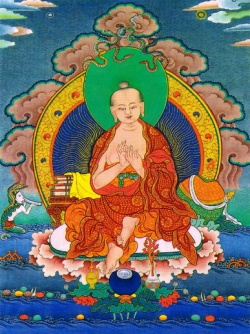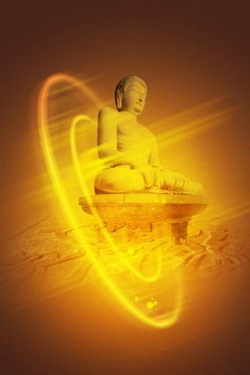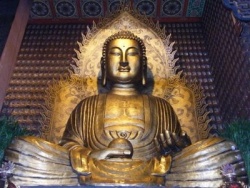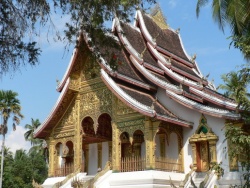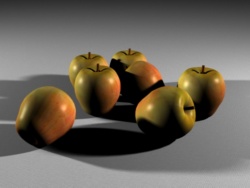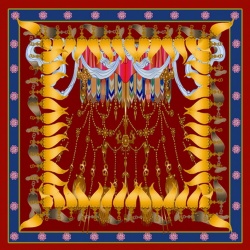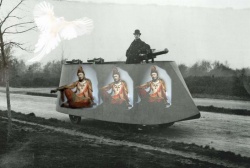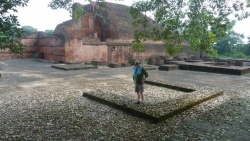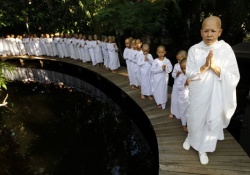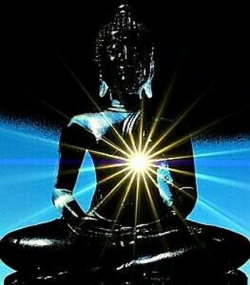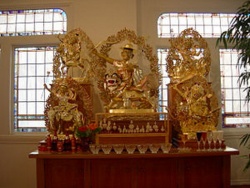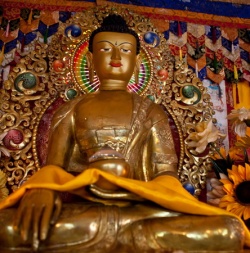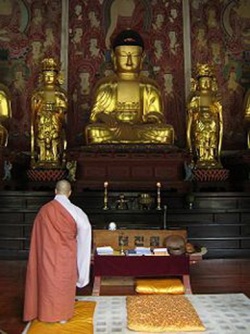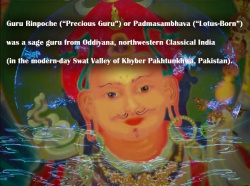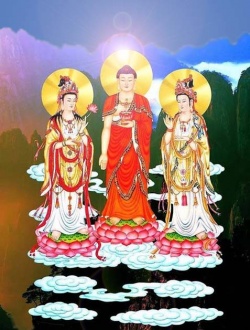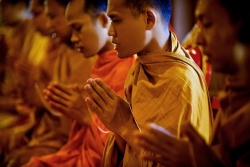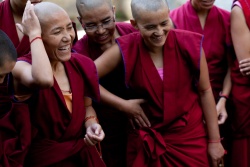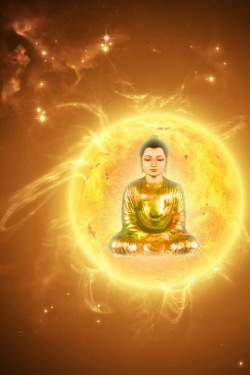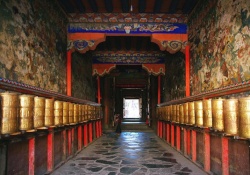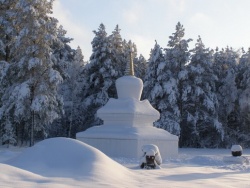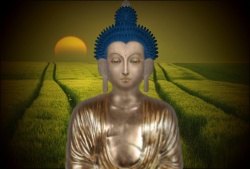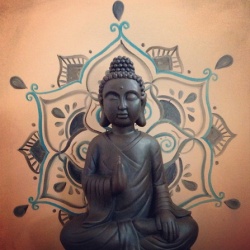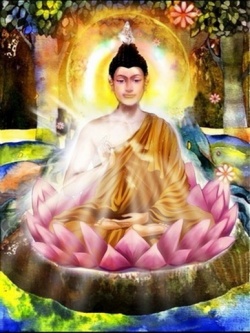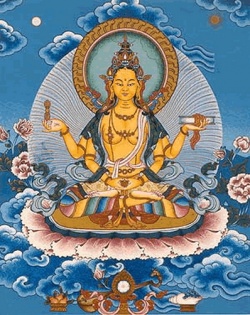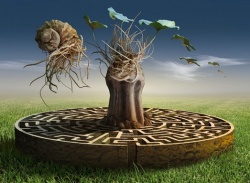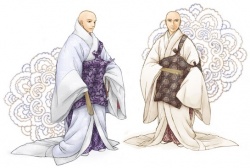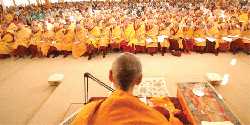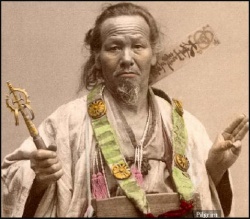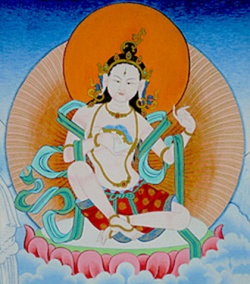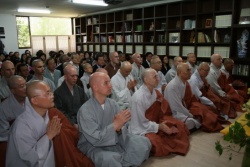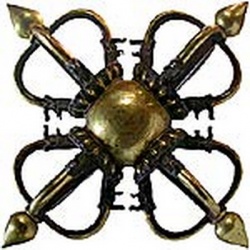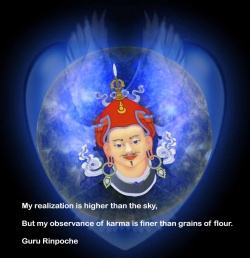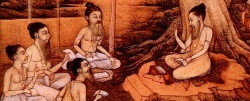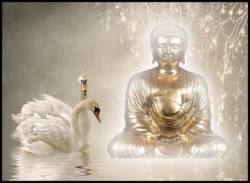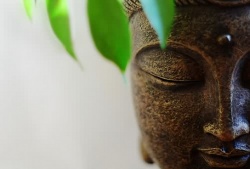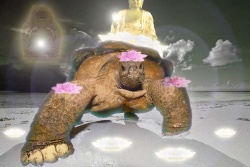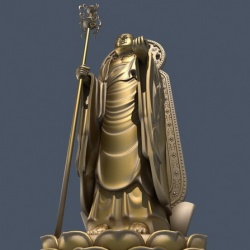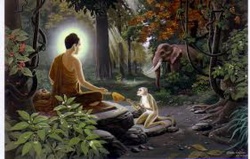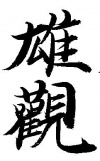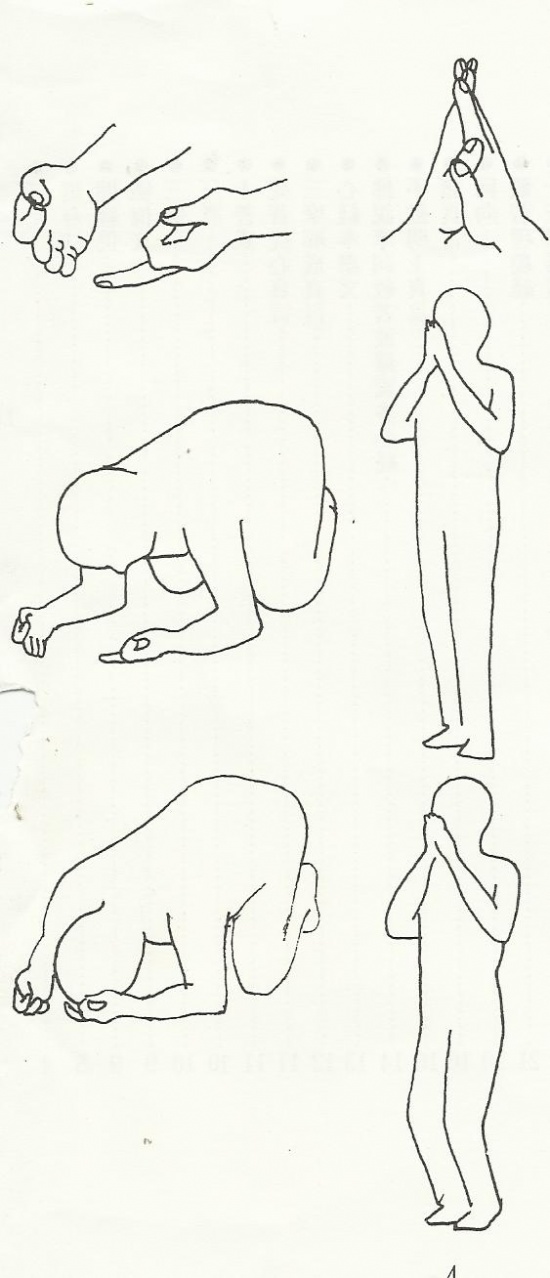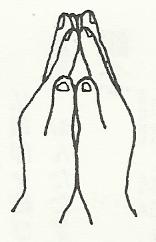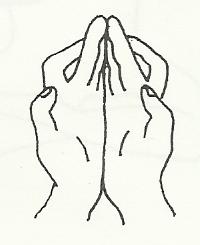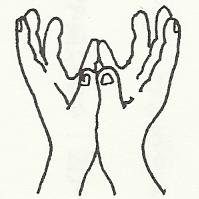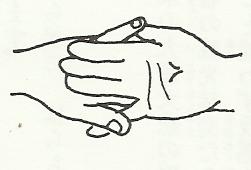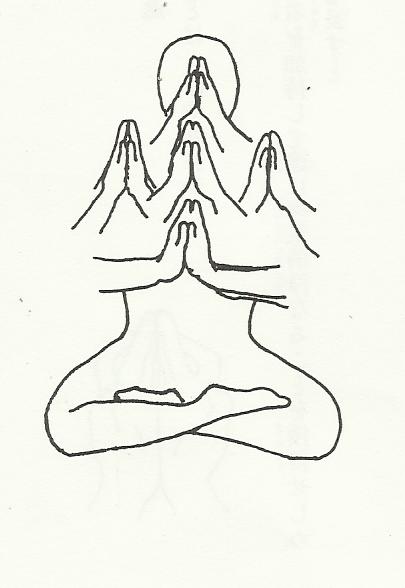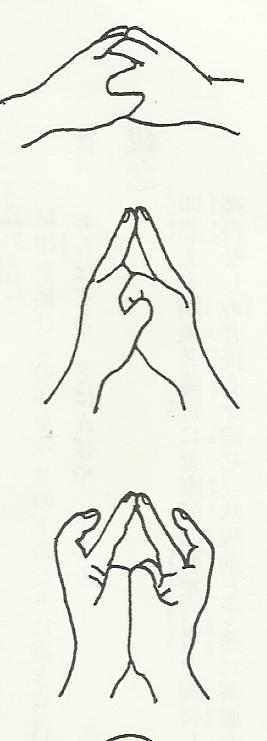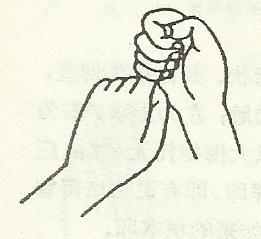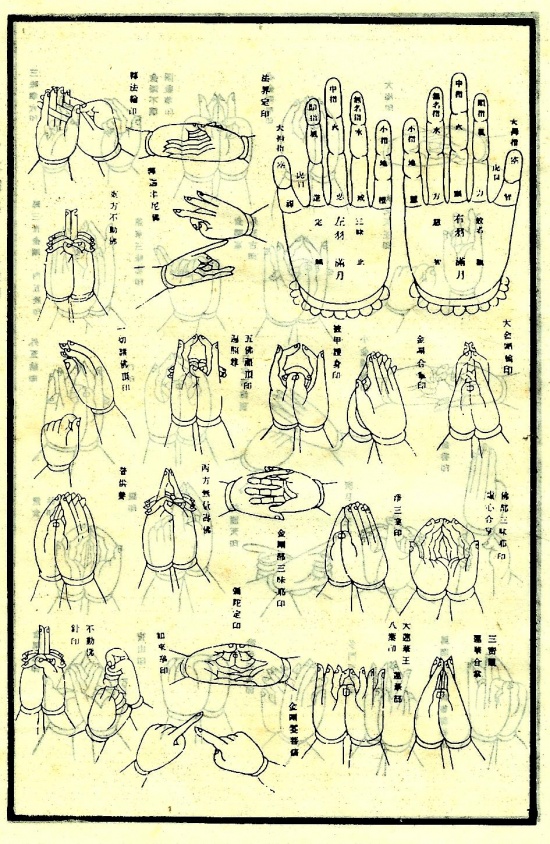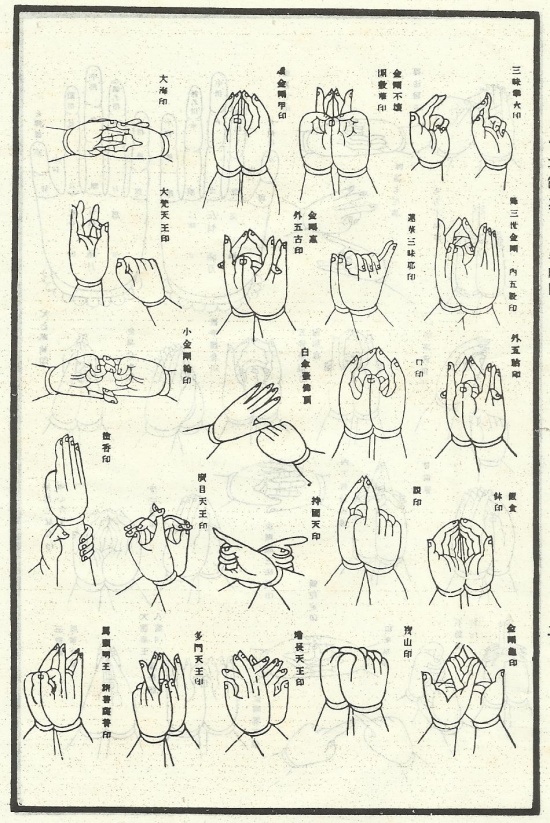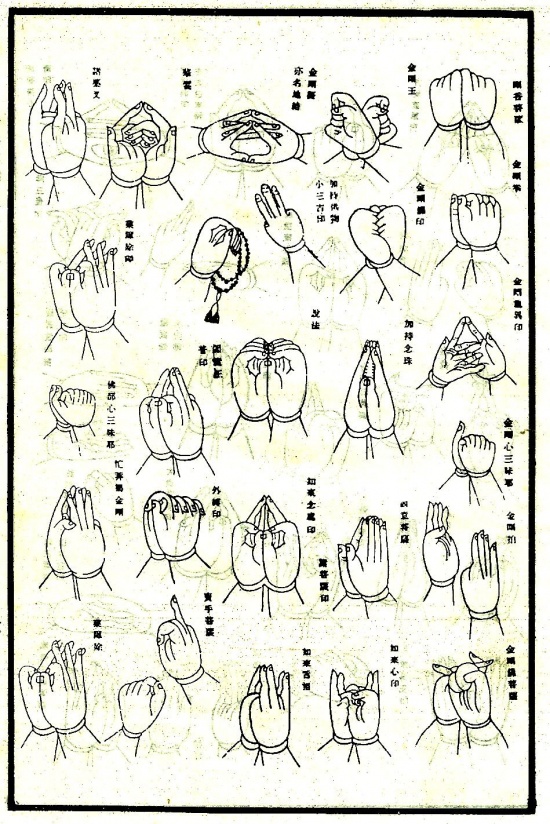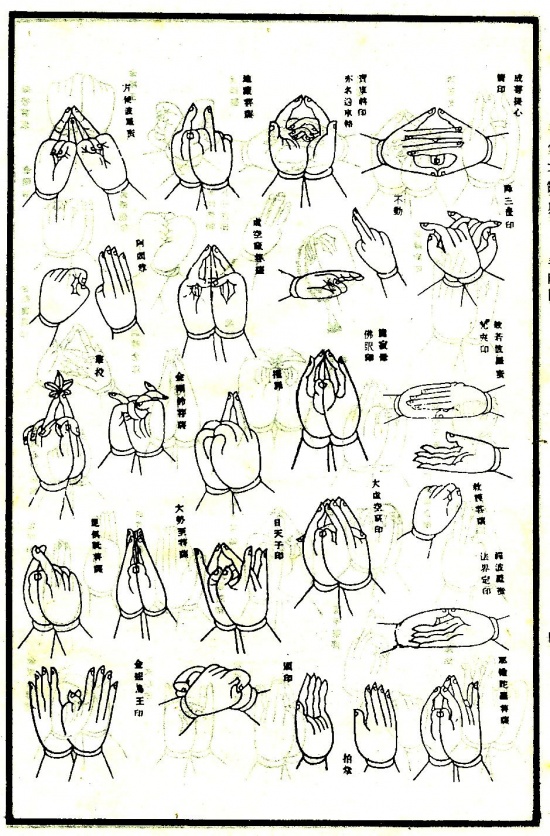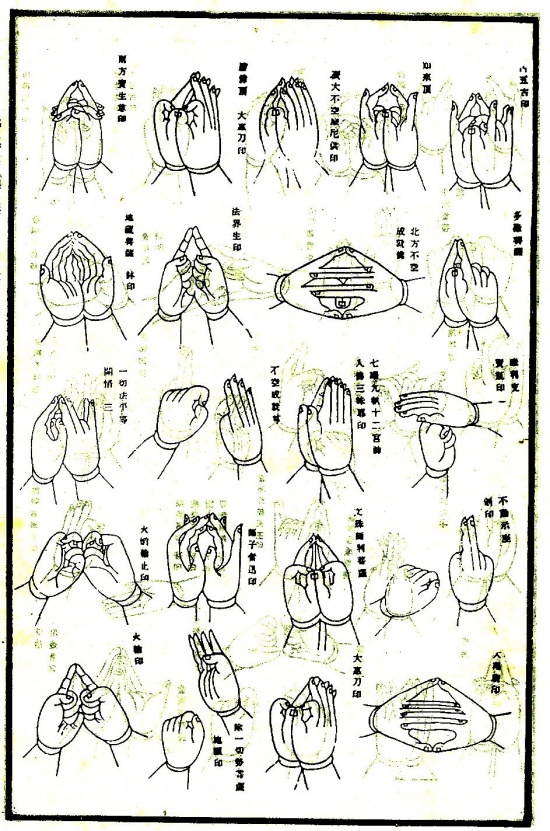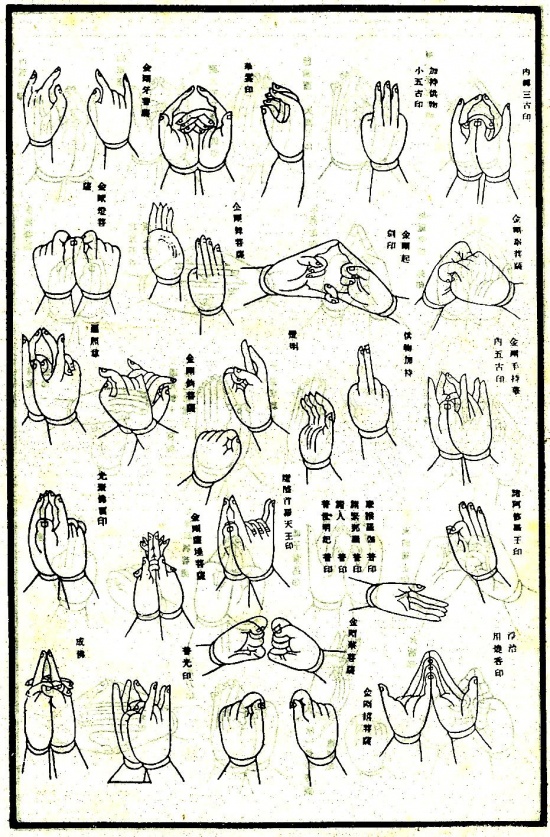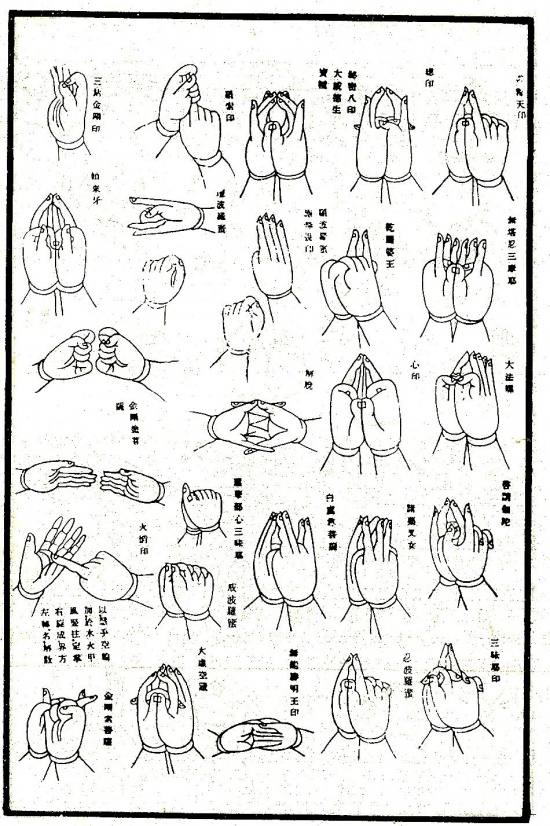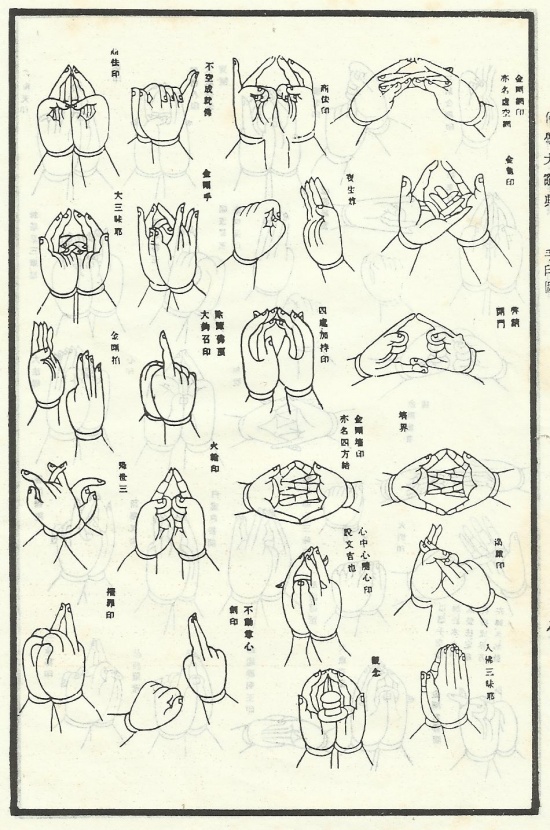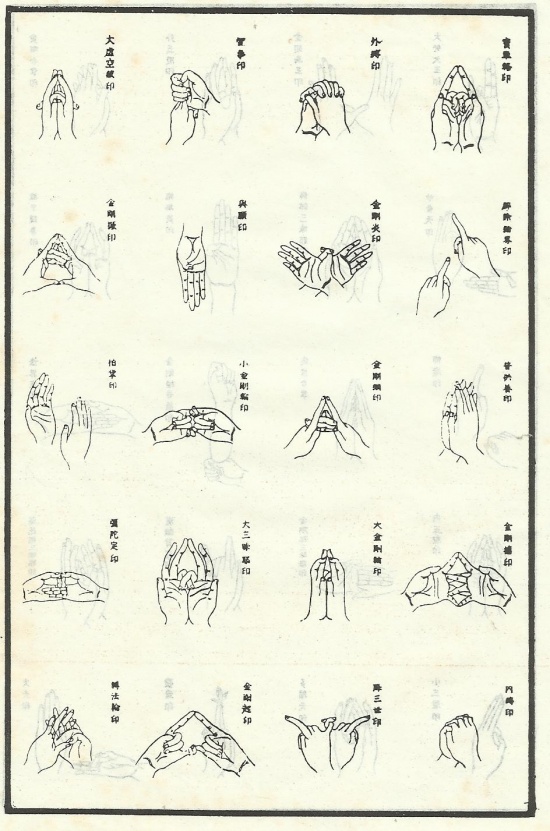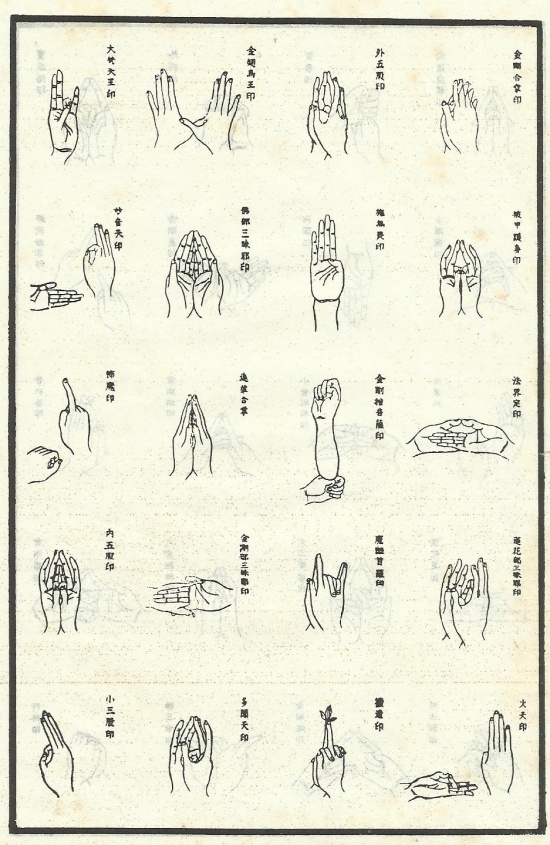Rishushakukyo Prajñāpāramitā Nayasūtra: Daily Tokudo Recitation
Rishushakukyo Prajñāpāramitā Nayasūtra
Demythologized, Enlargement and Compared with the T’ang Chinese translation
1935 English Translation of Doctor Ryūjo Kambayashi of Koyasan University
Daily Tokudo Recitation
The Mula-Sarvastivadan Tradition brought to Japan by Saint Kobo Daishi was a remarkable return to the Humanistic Behavioral Psychology of the Teaching of Gautama, our Original Teacher from India.
Unlike the Buddhist sects of Nara Koyasan is a Humanistic Buddhism based upon education of a person to become a Buddha in this life (jitsu no gotoku jishin wo shire).
The educational system of Saint Kobo Daishi would remain individualistic Instruction by a Preceptor/teacher who specially has created for a Tokudo (student/practitioner) who has left the home life for a vision of one of seeking his or her original nature the Pristine Cognation and to acquire the state of a śuddha ?/Buddha in his or her very own life time.
This was a great departure from both Neo-Theravada and the Mahayana that taught and some still do teach today that enlightenment is still far off for the majority of persons and Humanity. This was the reason that Saint Kobo Dashi had departed from Japan to go China to find a teacher who would open the Dainichikyo, that he had found and to learn its secrets to revitalize a form of Buddhism that he found at Nara in Japan.
It is remarkable to find a great man like Saint Kobo Dashi in Japan during the ninth century but he did occur. He was a reasonable and logical person expressing Humanism and concern in a society that was still feudal. He was a person who was a swift thinker and was noted for the accomplishments that were so great that he is well known all over Japan. He is best remembered not only for his creation of a Mulasarvastivadan temple complex call Koyasan, now a world heritage site, just outside of Osaka but for many pilgrimages centers and social intuitions for caring.
To understand his thought we must understand the very essence of Buddhism that he taught and this was Humanism. Humanity was the center and the creator of this world with its variety was within the very human mind and it was symbolized as the Inner Light that shown from the inside out with the name of Maha, the Great, Vairocana, Sun, who we lived, moved and had our being.
This was not an abstract thought but a very personal expression our own Pristine Cognition within our very mind like a reflection within our minds.
Humanism is the center of Saint Kobo Dashi concepts for realization which is Humanity’s very own Pristine Cognition, cintāmani.
Saint Kobo Daishi was so impressed and showed great respect to his teacher that he swore to him that he would learn and study and propagate it but this was not easy in Japan but Japanese did have the suitable nature for the concept of Humanistic Buddhism.
But the texts that he had were scanty and the circulation of the doctrine was thereby obstructed by this. So he sent his own disciples who he instructed namely Śramana Kōshu and Śramana Angyō etc. as teachers in some directions.
He held that if there are good men and good women in Japan who have the capacity of commitment for Humanistic Buddhism either Śramana or laymen, those who have the same intention as himself would also copy, recite and practice as it was written in the scriptures and consider it accordingly to reason . . .
they will realize Buddhahood in the mind. . . he wished only to propagate this knowledge so to give the advantage of the Five Wisdoms to Japanese and all Humanity which was clouded by ignorance and the release from ignorance’s clouding was the Humanistic Buddhism which he had learned from his very own teacher and he wrote this in 6th year of Kōnin – 815CE.
Saint Kobo Daishi concepts became the basic pattern for Instruction of the Mulāsarvastivadan Śramanas/ tokudos of Koyasan.
The Rishushakukyō was the key to open this Humanistic Door of realization and once a bhikshu of another sect asked to study the Rishushakukyō by a letter and Saint Kobo Dashi replied to him as follows;
- Now I opened your letter and realized your request to see the Rishushakukyō.
However, I suppose that there many phases in the Rishushakukyō (naya-principle).
What are the name and form of the rishu that you require? The reason of the Naya-sūtra, the sentences of the Rishushakukyō can not be covered with the vast heaven and the earth can not carry it. . . The Naya-sūtra can not be believed and understood without the power of the instruction of a Tathāgata and of a vast mind of a Mahāsattva like the sky.
Saint Kobo Daishi goes on further by saying in a reply letter to him as follows:
- The excellent sentences of the Naya (principle) are immeasurable, limitless and inconceivable . . . First the Naya that can be heard, second is the Naya can be seen, third is the Naya can be thought. These are as follows:
- These three sorts of Naya are acted out and these are:
- First, Looking for the Naya in the mind, in your mind. It needs not to be looked for in the bodies or minds of others.
- Secondly, Looking for the Naya of the Buddha, it is what is realized in your mind, it is realized only in your mind. It can be seen in the mind of a Buddha but difficult to find in ordinary persons.
- Thirdly, Looking for the Naya in thinking beings, these are immeasurable for thinking beings (neurons and their systems) are in your mind. It should be looked and understood.
- There are three types of transmissions of Naya knowledge and these are:
- 1) the written letters (the true doctrine),
- 2) Contemplation (the true wisdom and this is beyond meditation)
- 3) Realizing true essential principle (the truth).
The putting Naya knowledge into the writing is a sort bending of the voice and many times it is not lasting as it was firstly spoken but it is temporary by cause and effects and is therefore edited.
The letters are produced by the combination of paper and ink-stick that are used for its printing.
This should be looked upon as in the paper and in the brush and in the scholars who produced them.
Looking at contemplation, it is seeing the mind and inner working systems.
It has neither color nor form. Nobody can take, like taking a ball, it for it is formless.
Nobody can give it like if it were something.
Looking for the true essential principle (Pristine Cognition) which has neither name nor form but is united with the void can not be found since there is only vacancy and nowhere can it be looked for it is there only.
Rishushakukyō is in fact only a name that describe three things, these are you very own Body, speech and Mind ( san-mitsu) where these come from we do not know and this I call Naya and for these are of my own personal body, speech and mind and this is the Rishu-shaku-kyo.
These three were unobtainable in the mundane self (ātman) or in the higher self (mahā-ātman) for you and for me. If both of these are unobtainable, nobody can require and nobody can give.
I can say that there are two sorts of these types of (principles) Naya. They are your Naya and my Naya.
If you look for your Naya, it is in you. You need not look for it in me. If you look for my Naya, there are also these two sorts (ātmans).
One is the temporary self of the five elements (skandhas) and the second is the mahā-ātman of the non-self (anātman). If you look at the temporary self of the five elements, the temporary self has no true reality.
If there is no true reality, it can not be obtained.
If you look for the higher self (mahā-ātman) of the non-self (anātman) you will find that it is the three mysteries of the body, speech and mind that you possess which is the Pristine Cognition of the Inner Light which we give the name Vairocana and this pervades everywhere.
These are also your own three mysteries and not separated from the fore mentioned.
They should not be looked for elsewhere but within your own mind in you very body.
If you seek and inquire after the Naya, you should follow the Buddhist Teachings as held by the Mula-sarvastivadan Tradition.
You should make a strong vow (samaya) and practice strongly so you can change your own life. Without this strong vow of crossing over (Tokudo) it is impossible to obtain Nobility of a Śussha/Buddha.
The transmission of the Naya Mind is from mind to mind. Writings become dregs, a worth less thing. If you are attached to these dregs it is also worthless and the essential truth is lost.
It is the manner of the foolish to forsake the truth and to pick up the falsehood.
Seeking the Way (Butsu-do), as a Tokudo, is the same as in the ancient days.
Persons today require it to gain fame and profit. Requiring for fame is not the proper intention to require the Way.
The intention of requiring the Way is by forgetting oneself just as Gautama did when he was a prince in the Brahmanical age. Confucius did not allow that one who hears a teaching and preaches it to others without practicing.
Saint Kobo Daishi understands that if there is an opportunity of hearing sermons is dependent upon the capacity of the recipient and if this capacity does not agree with what is being taught, the teacher can not teach them anything,
because the Buddhist Dharma is inconceivable for most those who are with out trust in Gautama logic and reasonable words will not understand..
When the Tokudo affirms trust in the Three Jewels then he can enter Buddhism.
If he talks about of belief and practice and does not have it firmly in his mind, he has learned nothing for it is like a having a head but thinking by the tail.
If a Tokudo does not practice, there is no real belief.
If one begins will finish well, for that one is a Noble Person.
If a tokudo believes and has trust in the lessons that person can learn, whether one is a man or a woman, this one is the true and noble person of Humanity. Regardless if he or she was noble or the ignoble, everyone is capable.
When the capable man or woman comes and knocks, the bell is tolled and everyone will hear their knocking and then he or she will come into the Iron Stupa, where higher teachings are stored and sit with Gautama and hear the Dharma from the Tathāgatha through mind to mind and not form to mind.
Tokudos must pay attention to the admonitions of the saintly teachers that the excellent dharma should not be handed down recklessly. If the tokudo does not transgress the vow (samaya) and does observe this Naya in their own life,
and keep the four grave disciplines they will be cherished, if they perform awareness they will know innately the secret doctrine of the Five wisdoms of the Pristine Cognition which is Mahāvairocana the king of their own mind
in the form of Śuddha-Amidaba-Avalokita. This precious jewel (cintāmani-avalokita) will be in very person’s own mind (unīsa) and can not be regressed from it.
When Saint Kobo Daishi was asked about his interests in schools he wrote the following:
- I, Kukai, have an intention to deliver people . . . In the great T’ang China private schools are established to teach children in the blocks of cities, and district schools are opened to lead youngsters in many prefectures.
So wise and intelligent men overflow in the cities and learned men are full in the country.
In this city of Heian (Japan) there is only one college but no private schools. Therefore there is no place for youngsters of the poor and ignoble to look for instruction.
Ones who like learning in the far-off villages are very much tired in going and coming. Now I wish to deliver the ignorant youngsters by establishing schools . . . it will be for good causes of three points (dharmakāya, prajñā, moksa) for attaining Humanistic Enlightenment . . .
The school was named the School of Planting Knowledge by comprehending all the learnings. (5th year Tenchō/828).
The very base of the Mulasarvastivdan Koyasan Tradition is the Ācārya (Teacher) Tokudo (student) relationship, which was considered to be a private individual communication between the Ācārya and the Tokudo and it was so private that no one except the two aforementioned can be there when instruction is being given. To understand this relationship the terms Ācārya and Tokudo were well defined and still adhered to even today.
The Ācārya was just not an academic but a man or woman of experience with the concept of the Mind as conceived by the Sarvastivadan Tradition that anyone of practice could and would become a śuddha/Buddha, for it was in the scope of the human life in reach of every person of commitment.
Saint Kobo Dashi’s teacher, Ācārya Huikuo of the Ch íng-lung-ssŭ a disciple of Tripitaka Amoghavajra told him the following:
To know the mind of the Buddha is to know the mind of the Humanity. To know that these three minds are all the same is called the great enlightenment (mahābodhi). If one wishes to get the mahābodhi, one should learn the teachings realized by the Buddhas.
The self-realized doctrine is the so-called one hundred thousand gāthā of the Tattvasangraha and the one hundred thousand gāthās of Mahāvairocana-Buddha.
These scriptures are the doctrine that the dharmakāya who is pure and marvelous in the three times Mahāvairicana-buddha preaches this always . . . You should receive these teachings and should realize these by yourself and let others realize them too”. (828CE)
Originally all instructions for tokudo who wished to become a Śuddha/Buddha were created in the hands of their individual Ācāryas but latter, as the centuries went on, ritual books were published so the instruction became standardized.
However even today Ācāryas will change the language and methods according to their basic intuitions about the tokudo as did my Ācārya in Showa 63.
The Ācārya is a guide using a Behavioral Modification Methods created by Saint Kobo Daishi as found in the Dainichikyo to return the human individual to their True and Pure Nature the Pristine Cognation which is the Gem of Correct Thought, Cintāmani.
Rishushakukyo
Prajñāpāramitā Nayasūtra
Grade 1
Proper Instruction
Once Humanity learned the Teachings of Gautama and all of the Tathāgatas, that the world was really Pure by Nature and is like a sutra that can be read because of the innate human Pristine Cognition that gave perceptiveness within the human brain and these appears can be likened to five forms :
- 1) the Great round mirror perceptiveness that everything is a reflection;
- 2) the perceptiveness of equality;
- 3) the perceptiveness that observes everything without hindrances;
- 4) the perceptiveness that accomplishes the practice to profit all people;
- 5) the perceptiveness of the essence of absolute Truth, the Pristine Cognation, can be found in every mind that creates this very world of ours for the world is personal and unique to each individual but is also shared with all sentient beings and especially found among humanity which is the form for where this state takes it highest state, śuddha.
Once any person in Humanity who has obtained the use of his or her innate perceptiveness (Five Wisdoms) of the Pristine Cognation he or she has became a King of the Dharma (dharmarāja) and now can realize all perceptiveness which are known by all those who are aware of the Truth of perceptiveness and therefore themselves individually and are uniquely truly free in a unique union with each other in meditation and practice.
What this means is that every human person has innately from before birth what is called the Three Mysteries which is the use of the of Body,
Speech and Mind and the functions of these three are uniquely and exclusive to Humanity and are by their very nature are pure therefore the impurity that is sometimes conceptualized about some actions is only contextual and not innate.
These desires as follows:
1) sexual; 2) direct desired passion; 3) inseparable attachment; 4) voluptuous enjoyment; 5) looking at things with passion; 6) embrace with passion; 7) the attachment by love; 8) pride; 9) ornament; 10) refreshing the mind; 11) brilliant light of the intelligence; 12) ease of the body; 13) seeing; 14) hearing; 15) smelling; 16) taste for enjoyment.
What is considered impurity is only a situational state and this is due to ignorance of the person or persons within a situational situation that forms and creates the action being done in what is considered to be the present and then is judged as moral or immoral by societal norms or conventions.
Everything relating to these situations is the input of sense data is executed by the senses organs and these inform the brain of any object or objects before,
behind or to the side it, therefore these just by themselves are pure and neutral of any action for they are without situation but once they are placed in a situation and then and only then will they are judged by others that are either apart or not apart of the action or situation.
It is understood that if a practitioner who daily reminds himself or herself of the following:
- 1) Dharma of Purity that is Innate in all by their lifestyle of Compassion and Goodness to others;
- 2) reminding themselves by daily reading, reciting and or writing this Dharma of Purity and so therefore reinforcement this concept within their mind will form a habit of the Vajra Samādhi which becomes such a solid base that many things will be view in their unique equality which causes the person to be free and unattached.
These two processes give the best freedom and pleasure within in our current form as a Human Person and therefore from our heart a sound like Hūm will resound as a testimony of the firmness and essence of a true vow that is like a vajra.
Grade 2
Assembly of the Naya of Vairocana
The texts of the Prajñāpāramitā were written to give rise to the Wisdom of the Tathāgata who understood and realized that the reason of the Letter A and through this he had achieved the wisdom of one who has impartiality that is solid like a diamond and this is due to the solidity of the Pristine Cognation which is in born in each human person.
This lends a form relationship which will be called the Four Wisdom as follows:
- 1) One who has the wisdom mind of equality: symbolized by Tathāgata Aksobhya;
- 2) Equality of the advantage (arthasamatā) because great enlightenment gives the advantage to all the worlds: Symbolized as Tathāgata Ratnasambhava;
- 3) The one who realizes this is because of the Pristine Cognation: Symbolized as Tathāgata Amitābha;
- 4) The one who perceptiveness of observation creates a Buddha Field and Teaches the Truth : Symbolized as the Dharmakāya;
All of these Four Minds above will give rise to equality of all deeds, non-discrimination as an orientation at a personal level with the non discrimination of a Śuddha which can be obtained by all in this life and in this very body.
O, Humanity, if anyone one of you who will listen to this dharma, these four śuddha minds will rise up in him or her either by reading, reciting and or keeping it in his or her own mind, and even supposing that even if anyone of theses persons has committed immeasurable grave crimes, with this knowledge they will surpass all their bad ways for good ones and will be seated in the place of enlightenment and from there be quickly realized to the highest enlightenment.
This habitual practice of this concept of non-discrimination will enable the person to become a person of great liberty and great ease for he or she will accomplish great things and create advantages for all without effort or thought for it will have become innate within that person.
Grade 3
Naya of the Conquer of the Three Worlds in the brain
The Pureness of all things is being well established in the Prajñāpāramitā texts and this establishes the foundation for the practitioner to give rise to be best victory and that is the quality of truthful speech (samādhi of the Vajrasattva).
This reveals to the practitioner that both vain , non-vain and wrathful speech are by nature neutral until a situation where correct speech is to be applied and what is correct or incorrect according to the situational context of the action.
Therefore, such an innate way of a pure purport of speech will give the capacity to the practitioner to realize the highest enlightenment.
The use of speech can change and end a frustrating world and make it into bliss of Nirvana in the here and now.
Grade 4
Naya of the Responder
When the practitioner has obtained the quality of purity of one’s own nature) and one freely observes everywhere and in everything the equality of all the dharmas. Because of this:
- 1) everything in the desire world is pure and this includes even anger when used in the correct situation and
- 2) every thing is free from dirtiness because of innate purity of all actions before volitionally acts of ignorance and
- 3) the world can be and is by nature a Pure Land . When one keeps his or her attention to all conditions of things according to their cause and effect and that one is freed and is pure innately.
The purity that is therefore transfixed through the Bodhi-citta and even thought as it is sometimes surrounded by ignorance of thoughts and wrong choices the essential quality is always the same Pure and not changed in a person who is now a śuddha, a person who has changed himself by himself and now has no regression to the lower level of ignorance.
Grade 5
Naya of Akāśhagarbha
The Empowerments are ones of self-resolved by the person to reflect their own Pristine Cognation/ Inner Self Radiance/ the Light that shine from inside out.
Humanity has never been fallen or lost it Pure Nature and because of this so called Empowerments are never from without but only from within i.e. the Pristine Cognition.
There are no blessings, mudras or rites only the Pristine Cognition and this gives the resources that will bring about of all wishes.
This pervades the three worlds of the person i.e. past, present and future for these are all mind made and mind controlled.
The only thing that is required is firmness that gives the position of a Buddha (śuddha).
The process follows a systematic symbolically named process samādhi of the Bodhisattva Vajra-ratna that give the abhiseka that leads to the various paths of dharma-raja in the practitioner’s past, present and future world and the process is thus:
- 1) Samādhi of the Bodhisattva Vajra-teja that gives resources to śramanas and Brahman so they will complete their desire for awakening;
- 2) Samādhi of the Bodhisattva Vajra-ketu that lets them take the dharma to all beings and let them be satisfied in all the dharmas and to give them rise to the profit of the Buddhist dharma;
- 3) Samādhi of the Bodhisattva Vajra-hāsa and supplies even the animals with substance. The practitioner even gets ease of acquiring these three.
This is put into a Bīja word Trām and in this letter is a symbolic of the vow of Ratnasambhava Tathāgata who let the practitioners to acquire the position of the Buddha by all the abhisekas.
Grade 6
Naya of the Vajramusti Śuddha in this body and in this life
All the descriptions of the body visual forms are just forms to help the persons mind to relate to the correct position of Purity of All Things or Nature.
1) Practicing the Kāya mudra he or she can become the Tathāgata.
2) Practicing the Vanmudra he or she can become a Tathāgata;
3) Practicing the Citta mudra can become into the sphere of the enlightenment of all the Tathāgatas
This can be only done in the mind and the practitioner can achieve Purity of the Triple Mystery i.e. body, speech and mind. Constant Awareness of this will give direct rise to enlightenment.
This ability is natural and is self propelled by the brain itself and there is no need for extensive rituals for once the will to do is in place, to be a śddha, it is done by the self and for the self.
Grade 7
Mañjuśri: Naya of The Buddhist Teacher
The Teachings of the Sacred Letter A ra pa ca na is the purport of the Prajñāpāramitā.
L1) Things as we call them are in fact vacant, because they are non-substantial, Vajratīksna.
L2) The dharmas have no form, because they agree with formlessness, Krodhavajratīksna.
L3) The dharmas are of the great vow have no substantiality, because they agree with non-substantial but in reality nothing is real or un-real, full or empty that is just a conception all is mind alone Padmatīksna-vijaya mandala
L4) Dharmas are brilliant paramārtha –artha in the sarva-artha siddhi-mandala.
Mañjuśri kumāra rotated the wheel of the five letters that are naturally with in the human brain,
Grade 8
Naya of Virtues
Awareness comprehends all Virtues.
A practitioner realizes that everything that pervades is Pure equally is one who is a sacred one in the graphic mandala of Great Compassion which is just the picture of the abiding Pristine Cognition within the brain and its alignment with the other cognitive functions.
With this realization the practitioner is free without hindrances in all deeds. He is now connected with the desire for all sentient beings to enter the dharma of Pure Conduct).
Grade 9
Naya of True Adoration
Sarv-pūjā-vistara-bhājana Bodhicitta is produced when desired by the practitioner the deliverance of all sentient beings and this is because it is the desire of all those who have become, or are becoming those being of great intent and this is shown by the adoration towards this teaching.
To keep this text is the true adoration to those who have learned it and now live by it; it is a living adoration of a song of the Pure Life and becomes an unfailing vow and shows to all the works of Great Compassion.
Grade 10
Naya of Sarvamāra-pramardin
The Sarva-māra-pramardin is the conquering of the hindrances of ignorance that plagues this world and its treatment for cure is knowledge obtained from the Prajñāramitā.
All the sentient beings have equality. All of them have the mind of anger.
So the mind of anger should have the equality. All the sentient beings can conquer their anger by themselves like the victorious one.
All of them have had a mind of anger but that mind was conquered by still a bigger mind generated by them that could control this anger by awareness of body, speech and mind.
All the sentient beings have dharmatā.
All the sentient beings have the true nature of Śuddha which is solid like a diamond. All sentient being have an innate mind of defense and protection that is also solid and what is the reason for this? It is that when a practitioner becomes aware of whom he or she really is and therefore takes charge of his or her life the enlightenment is realized.
Grade 11
Naya of Samantabhadra Vajrapāni
The expression of the Pure Bodhi-citta (Samantabhadra Vajrapāni) is a graphic symbol for this innate mind which is in all the human beings and this gives birth to the most excellent samaya of establishing the equality of all. Because of this the following occur:
- 1) All human beings have this nature of equality which is the innate enlightenment, so the Prajñāpāramitā has been written to express this nature of equality.
- 2) All human beings have this innate nature of cintāmani, and the Prajñāpāramitā reveals this through reading, writing and hearing and for the human brain is already programmed by this innate nature of cintāmani i.e. samatājñāna.
- 3) All the human beings have this innate truth and therefore the appearance of this truth is Prajñāpāramitā.Cintāmani is called the pratyaveksana-jñāna.
- 4) All human beings possess the triple mystery of Body, Speech and Mind, the Prajñāramitā is based on this of humanistic method of instruction.
This is the samādhi of which the practitioner enters upon in the Prajñāramitā becomes Samantabhadra-vajrapāni under the adhisthāna of all the Śuddhas in the vajra-samādhi.
Grade 12
Naya of the ultra-vajra section
The when the mind of a person realizes that:
- 1) Humanity and all beings can become Knowers: Tathāgata
- 2) All Humanity and thinking beings have the ability because they are birthed from the womb of Knowing): Samanta-bhadra.
- 3) All Humanity and thinking beings have the ability because they have virtue of Humanity (Vajra-dhara) of innate virtue: Ākāśa-garbha
- 4) All Humanity and thinking beings have the ability because they are the depository of Good Dharma for they have true speech which is the appearance of this depository: Avalokiteśvara
- 5) All Humanity and thinking beings have the ability of virtuous conducts, every being, no matter who they are and they have the nature of equality. The actor and the acted and the inter-communicated and all practitioners attain the karma-pāramitā.
All these five classes and their forces to work because of these four depositories are endowed in all Humanity and thinking beings.
Grade 13
Naya of the Seven Mothers Goddesses
- 1)Cāmundā;
- 2) Kauverī;
- 3) Vaisnavī;
- 4) Kaumāri;
- 5)Aindri;
- 6) Raudri;
- 7)Brāhmi who were overjoyed to hear about that Humanity was endowed with virtues of the Four Depositories.
This rejoicing is what makes a practitioner free from obstacles and to attain the practice.
Grade 14
Naya of Three Brothers
Brahmā; Nārāyana these three brothers gave homage to Gautama the Śuddha.
Grade 15
Naya of Four Sisters
Jayā; Vijayā; Ajitā and Aparājita admire Gautama the Śuddha that they dedicate themselves to the Tathāgata showing their obedience to the higher knowledge of Humanity who now has the dharma of the Prajñāpāramitā.
Grade 16
Naya of the Mahā-mandala of the Four Pāramita's
The to make the understanding of the Teachings contained in the Prajñāramitā more cumulative and perfective, the Tagathāgata taught the purport of the Prajñāramitā in a parallelogram form and ultimate equality of many dharmas.
The Prajñāramitā belongs to the dharma of Vajra-kula. This teaching of the Prajñāramitā of the vajra-kula is considerable.
All the Tathāgatas that are represented by symbolic and physical forms of persons in the mandala (schematic) of the vajra-kula are beyond measure.
The Prajñāramitā has limitless virtue and these are expressed in the Four Pāramita:
- 1) All persons who have experienced this and have realized and are now call Tathāgata know that this experience of śuddha is limitless also.
- 2) All the dharmas are originally equal and never left to become inequality; they have only one taste and therefore only one equality.
- 3) The Prajñāramitā can manifest in many forms of dharmas has only one taste and only one quality.
- 4) All the dharmas which are these manifestations (good deed of all five families) and theses are accomplished by the Body, Speech and Mind.
So the Prajñāramitā is the completion of all these good advantages of oneself and of others (Karma-kula- Action-family).
Grade 17
Naya of the Five sorts of Five Mystic Samāhi
Now will be reviewed the concepts of the firmness of non-vain speech and non-vainity, the sphere of the five mystic mandala that are always equal and plenary in all the three epochs of time.
- 1) Gautama had a great desire to deliver all sentient beings (those who have the capability to know) from frustration. So because he is a Śuddha he accomplished this not only for himself but also became a supreme guide for others.
- 2) Gautama accomplished this practice of great joy (Nirvana) not only for himself but to be shared to all sentient being lost in the sea of frustration. So he accomplished this practice by the purport of the Prajñāramitā which is purity and non-attachment of everything.
When the practitioner has enlightenment and has non-vanity, this is when he can realize the purity of all the dharmas, and that there is no good or bad dharma by nature in the dharmadhātu.
- 1) There is no powerful Mara but all is created by a single mind of one self and can be conquered by Wisdom of the great enlightenment.
- 2) When all the obstacles placed by in the mind by ignorance the dharmas now placed in that mind are filled understanding of Wisdom. This mind is one filled with light that makes this world, to that person, a Pure Land of the Śuddha Amitaba.
- 3) There is not distinction of the ordinary person and the sacred one. He or she is the Dharma-kāya in this constant world. He or she is pure without any obstacle in the three measures of time.
Such is the accomplishment of the Śuddha who is at liberty in the triple world. When the practitioner performs the deeds of a Śuddha he or she becomes a lord of the triple world in the very body in this very life. He or she can deliver all the sentient beings in the frustrated world as a guide. He or she will live with all the sentient beings with this great effort and assist them in dealing with life and death. He or she can be likened to a sphere where the actual matter is the truth and the actual life is this true world.
What are the reasons for this?
- 1) Now this very skilful Śuddha/Bodhisattva cooperates with all sentient beings in pain and joy. He or she devotes his or her life to the advantage of all sentient beings. He or she never goes to the blissful nīrvāna alone.
- 2) He or she makes all the dharmas and the sentient beings in the triple world to realize their own purity through the teachings of the Prajñāramitā that is the excellent and pure wisdom and an excellent to carry on the wisdom for delivering sentient beings.
- 3) He or she removes the crimes of the entire world with the great desire to rescue and protect all the sentient beings and thereby he or she conquers all the sentient beings in the triple world from the highest to the lowest.
- 4) When this Śuddha-vajra-sattva dwells in the triple world with the wish of Great Compassion just as the reddish padma is not dyed by other colors, the Śuddha-vajra-sattva who is in the world of desires, is not soiled by many desires. He or she dwells in the purity and gives advantage to the sentient beings.
- 5) When the great desire to rescue beings arise, he or she gets great ease of the advantage of him or her self and others. He or she keeps limitless treasure of virtue and becomes the Lord in the triple world. He or she can fulfill the excellent deed of protecting with the indestructible solid mind.
O, Humanity, if one listens to this purport of the original Prajñāramitā, recites it daily in to only in words but deeds in the morning and listens, he or she will get all the easiness and pleasure, the true and adamantine accomplishment of utmost, he or she will get the freedom in all dharmas.
He or she will pass through the sixteen levels of the Great Sixteen Bodhisattvas and then they will acquire the position of a Vajradhara of the Tathāgata.
Appendix
Ritual Forms
Bowing before recital:
Om, sarva Tathāgata-vandanam karomi
(Om to all the Truth Knowers I touch their feet in reverence)
Five Mudras
Om savabhāva-śuddāh
(Om all the Dharmas are pure by Nature)
Sarva-dharmah, svabhā-vashuddo HAM
(I am also pure by that same Nature of Purity HAM)
Om Tathāgato – bhavaya Svāhā
(Om to the Knower born Hail)
Om Padmo – bhavaya Svāhā
(Om to the Lotus born Hail)
Om Vajrod – bhavaya Svāhā
(Om to the Vajra born Hail)
Om Vajragni-pradiptaya Svāhā
(Om the Imperishable Fire of Wisdom of the Truth of Purity Hail)
Om AH Svāhā
(Om AH Svāhā)
In an unpublished article by Dr. Leo Purden, that I found stashed in a desk at SaiFuKuji, were he questioned the transmission of these mudras and rites over the centuries in Japan.
It seems, according to his research that many of the Shingon-shu Ācāryas had added and subtracted according to their own limited knowledge and ability because they did not fully understanding Saint Kobo Daishi’s concepts, therefore over the centuries this led to a change in how the system worked. He felt that this was reflected in the various “standard” manuals written by these Ācāryas that are used still today, showed their basic differences with their founder, Saint Kobo Daishi.
This might have been insignificant but this created a shift for a therapy to change the view of a mind clouded by non original ignorance that could be changed by a Behavioral Modification Method by one’s self to one of a ritual or service directed towards some deity for a magical result either for good luck or protection.
The following pages of mudras, without their mantras, are a physical reinforcement of abstract concepts as found in the various sutrās that Saint Kobo Dashi had discovered or in some cases created for a tokudo to learn to read the Rishu-shaku-kyo that was innately implanted in the human mind and could be read by each human person as soon as they learned how to read the words if it were.
The Practice of the Rishu-shaku-kyo was the reading course to teach this method and not a magical rite or system.
Everything was adjusted to a medieval T’ang Chinese or Japanese mind to learn from a created unique experience by an Ācārya for this type of person, however these people no longer exist and hence the need for a creation of manuals and commentaries. These were written so who that ever used them thought that they would understand this medieval frame of mind but in reality this is impossible since the compiler and the reader were themselves separated by centuries from the era of textual composition and culture. It is my opinion, as it was that of the late Dr. Purden, that this was the reason for a great change that caused Shingonshu to forget the thought of Saint Kobo Daishi and this led Ācāryas to mispronounce the mantras and not to understanding of abstract concepts of his psychology that sometimes creating no positive result except an addiction to superstition and magic.
This is the reason I do not suggest that a Ācārya of today needs to follow these type of texts but to use them to create new Behavioral Modification text, based upon Saint Kobo Daish’s unique understandings, for a modern world in a purely scientific method of Observation, Experimentation, Theory and a replication according to Reason and Logic in the Mulasarvastivadan tradition and in this way the person could acquire by his or her own unique abilities as found in their own edition of the Rishu-shaku-kyo as recorded in their own innate Pristine Cognition found in their very own mind created by Genetics and Evolution.
The Mudras pictured below are taken for a standard text encyclopedia in Chinese but reflect Japanese Koyasan Shingon shu texts compiled in Taiwan by Saykapa. These are arranged according to a ritual sitting based upon the sixteen mudra rite (juhachido) and then the others are based on various practice rituals from the Dianichikyō. I am of a conviction that some of theses could be used or not at the discursion the Ācārya for a tokudo practice that is fitted for a particular tokodo’s needs and abilities. I have found that these mudras still have value as a tool to recall basic texts even in a non-liturgical setting for the benefit of others.
This learning is best directly from a Ācārya and not from a text as some Buddhist schools do. Nothing replaces the human factor of the Ācārya in the Koyasan Mulasarvastivadan method for it is mind from mind transmission only.
Bibliography
- Dianichikyō-kaidai , 7 recensions. Kūkai (Kōbō Daishi, 774-835), Taishō, No.2211 Vol. LVIII.
- Dianichikyō-sho-monshidai, KūKai, Kōbō Daishi-zenshu, Vol.III.
- Shingonshū-shogaku-kyōritsuron-mokuroku: KūKai, Kōbō Daishi-zenshu, Vol.I.
- Taisho Daizōkyō, Zokukyōsho-bu
- Vol.LXI, Nos. 2291-2245
- Vol.LXIX, Nos. 2284-2290, Taishō, No. 1668.
- Vol.LXX, Nos. 2281-2295, Taishō, No.1665.
- Vol.LXXV, Nos. 2385-2408
- Vol. LXXVII, Nos. 2425-2460
- Vol. LXXVII, Nos. 2461-2509
- Vol.LXXIX, Nos. 2510-2542
Source
Submitted by Vira Avalokita


